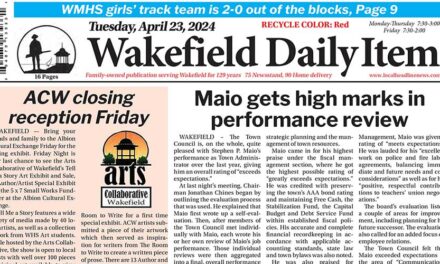Published in the October 22, 2015 edition
By MARK SARDELLA
WAKEFIELD — The Nov. 16 Regular Town Meeting will be asked to approve the purchase of a new pumper for the Fire Department to replace a current fire engine that is 20 years old.
Last night, the Capital Planning Committee voted to recommend the purchase after Town Administrator Stephen P. Maio went over the request and answered some questions from the committee. Fire Chief Michael Sullivan is away and did not attend the meeting but did provide a written commentary on why the pumper is needed.
The current Engine 4 is a 1996 Seagrave 1,250 gallons-per-minute (GPM) pumper with more than 98,000 miles and 11,000 engine hours, Sullivan states in his comments, adding that it has already served its life expectancy of 15 to 20 years.
Currently, Engine 4 is the reserve fire engine and is housed at the Greenwood Fire Station. According to Chief Sullivan, it is placed into service whenever the department’s other two pumpers or aerial ladder are out of service for repairs or maintenance. It does respond to major emergencies in town and is staffed whenever Wakefield apparatus responds out of town for mutual aid. It responded to 286 emergency calls in 2014.
When Engine 4 is replaced, it would become the active engine and one of the older trucks would move down to reserve status.
Sullivan says that repairs and maintenance on Engine 4 have been increasing each year. Repairs have included work done on the brakes, springs, radiator and electrical wiring. The main fire pump for the engine is showing significant signs of wear and the town will have to address major costs related to rebuilding this pump in the near future as it is approaching the end of its service life, according to Sullivan. He notes that replacement parts are expensive and difficult to find for a 20-year-old fire engine.
The new truck is expected to cost $650,000 and Maio explained that while the new pumper is a capital item, it will not come out of the capital budget due to the high cost. Instead the town will borrow the money through bonding but even that won’t happen until 2017 at the earliest Maio said.
If Town Meeting approves the pumper, the order will be placed but because all fire trucks are custom built, it will take about a year and a half for the new truck to be built after it is ordered. Maio said the town won’t have to pay anything until the truck is built.
The requested new truck will also be a 1,250 GPM pumper with a 750-gallon water tank, according to Sullivan. It will be equipped with modern emissions control systems making it more environmentally friendly and fuel efficient. It will also be equipped with modern wiring and electronic systems.
Sullivan cautioned that if Engine 4 is not replaced and breaks down, the Wakefield Fire Department would be without a spare pumper for more than a year while awaiting a new replacement. That would make routine maintenance of the department’s other three fire trucks difficult to schedule.
A major breakdown of Wakefield’s two other pumpers or aerial ladder truck would require the town to borrow a reserve pumper from another fire department. Any such reserve pumper from another community will be more than 20 years old, Sullivan warned, and Wakefield would be responsible for any repairs on borrowed fire trucks during their service in Wakefield.
The Capital Planning Committee voted unanimously to recommend the purchase.
—————
While the money to permanently repair the major water main break that occurred on Green Street over the Columbus Day weekend will not come out of the capital budget, Maio said that he wanted to discuss it with the Capital Planning Committee because it is a capital item that will be paid from the town’s water and sewer reserve funds.
Maio said that he had no cost numbers yet but expected them to be ready for the Nov. 16 Town Meeting, when an article to appropriate the funds will be presented. There was a lot of property damage incurred by homeowners, Maio said, as water gushed down the street and onto residential properties.
Maio said that he hoped that the cost would be in the lower six-figure range. The town will go through its insurance and homeowners will file their own claims. Maio did say that the town will pay for some of the damage incurred by homeowners.
Town Engineer Michael Collins was at last night’s meeting and said that while the water main was about 50 years old, it was still found to be at almost its original thickness. He said that it is often impossible to know what causes such a break. He speculated that it could have been a flaw in the grain of the pipe from impurities during the casting process.
Collins also discussed the town’s sewer inflow/infiltration process to reduce the amount of groundwater that seeps into the sewer system. He explained that the town’s older clay sewer pipes built decades ago can develop cracks that allow groundwater to seep in. That increases the flow that the town is charged for by the MWRA.
Collins said that by identifying major areas of groundwater infiltration the town can replace those pipes and save about $800,000 to $1 million annually in charges for sewage treatment by the MWRA.
A proposed Town Meeting article on the Nov. 16 warrant article would authorize the Board of Selectmen to apply for, receive and expend a grant/loan from the Massachusetts Water resources Authority in the amount of $1,017,000 for the town to use for its infiltration/inflow removal program.
Maio explained last night that 75 percent of the amount sought, or $762,750, would be a grant. The other 25 percent ($254,250) would be a no-interest loan from the MWRA that would be paid back over 10 years.




